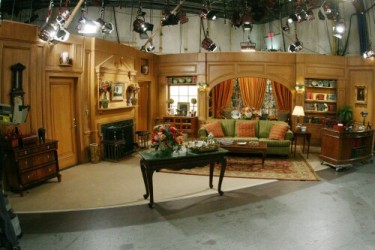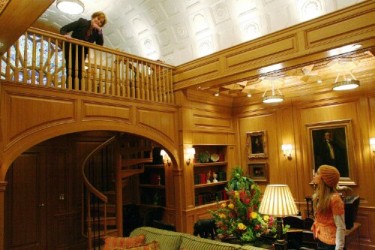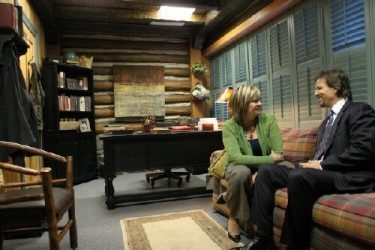"Guiding Light" Revolutionizes Daytime Production Models as It Enters the Digital Age

Guiding Light, the longest-running scripted series in television history – and the only one on the air today that began life as a radio program – has implemented cost-efficient new technologies and production techniques that will likely revolutionize the way daytime dramas are made.
These changes, which will fully be seen on screen as of February 29, also could provide advertisers with exciting new opportunities to reach viewers, even those who time shift and largely ignore traditional television spots.
Since returning in January from the show's two-week holiday hiatus, the GL team has been producing episodes in a manner radically different from that employed by virtually every daytime drama dating back to the Fifties -- a model pioneered by GL in 1952 when it made the move from radio to TV. Gone are the cumbersome two- and three-walled sets, giant pedestal cameras, dozens of overhead lights and miles of cable connecting all of the equipment. In their places are approximately forty permanent sets, each with four walls and a ceiling. On-set equipment now consists of three hand-held cameras, a few hand-held microphones and a couple of hand-held lights, and it is all wireless. (The photos below illustrate the differences between the old and the new Spaulding Study sets. Note the permanent ceiling in the new set.) The video and audio is recorded in sync on all of the cameras and microphones and is downloaded via wireless technology to a computer as the production moves through the day. Scenes shot in the morning are already being logged and edited by lunch. The massive control room that had hummed with activity for years is now dark. The new digital control room is the size of a closet.

The old Spaulding Study set

Marj Dusay (top) and Marcy Rylan on the new Spaulding Study set
All of this happens in the GL studio space in the CBS Broadcast Center in New York, but the production has also ramped up on a record amount of location work – all of it in the town of Peapack, New Jersey, which now doubles as the fictional town of Springfield on the show.
There is nothing like this being done with this technology anywhere on television – certainly not by a team that produces 260 hours of scripted dramatic programming every year. “We're not reality television, or primetime, or even a soap opera,” executive producer Ellen Wheeler told me last week as she took me on a tour of the New York studio. “Nobody is making this kind of television in so massive an amount.”
As we walked through the two-story labyrinth of sets Wheeler, who initiated the plan for these sweeping changes early last year, carried a small wireless monitor that allows her to watch everything that is being recorded by her three cameramen simply by pressing buttons below its six inch screen. It matters not where they are, or where Wheeler may be. She is always effortlessly connected to everything that is happening.
Wheeler explained that a confluence of events led to the decision to transform the day-to-day execution of the show and pioneer a new production model for the future. Early in 2007, as the kick-off to its 70th anniversary celebration (15 years on radio, 55 years on television), many GL cast members spent a week in Biloxi helping build homes for victims of Hurricane Katrina. Their work was recorded on hand held cameras. Upon her return, Wheeler watched much of the footage. “We were shooting reality in a real place with real people,” she recalled. “I felt completely connected to them. I told our production manager, 'This is how we're going to shoot our show next year.'
“Here we are, one year later, and it's happening,” she smiled.
Around the same time, Procter & Gamble Productions, which has owned GL from the beginning, had received the results of an audience survey that expressed a desire on the part of viewers that the show be made to “feel more real.” This was especially important to younger viewers who had come of age watching reality television programs.
“Procter & Gamble Productions called and said, 'We want you to make changes based on our research,'” Wheeler explained. “Find a way to make the show more realistic.” And shortly after that, CBS, the network that has run GL since its move from radio, indicated that it, too, wanted this aging franchise to be made newer and fresher, she added.
Wheeler described the transformation, which took place while the show was in production in virtually the same space, as “an unprecedented task.” She noted that she didn't have to hire new people to execute her plan. “All of my team rose to the challenge,” she proudly declared.
The new sets don't have to be assembled and struck on a recurring basis. “I don't need crews to stay overnight to put sets up or truck sets in,” Wheeler noted. The sets are permanent, if somewhat small – just big enough for the furnishings, actors, and the technicians holding cameras, microphones and lights. “I wanted the feeling of being in the room with the characters,” Wheeler explained. She got it.
What she also got is an increased attention to set detail. Every room is filled with small items that one might find in a real room of its kind. For example, as we walked by the permanent set for CO2, a Springfield coffee shop, I took note of a number of real life products placed about, including Bounty Paper Towels on a shelf and a bag of Pringles chips prominently displayed in a bowl on the counter. The items were not set there as part of a product placement arrangement – but other products could be, and given the show's new realistic look and feel, they would not appear out of place, as they often do on other shows.
“We've been doing product placement on our own without any deals,” Wheeler laughed. “When [the character] Dinah got pregnant we had her crave Pringles throughout her pregnancy. We wrote entire scenes around Pringles, even specific flavors.”
Another aspect of GL's new production design is its extensive use of locations, almost all of them in the town of Peapack, New Jersey, which will allow viewers to see the cars, homes, yards and haunts of the characters on the GL canvas. Viewers will get to know Peapack extremely well. Advertisers may want to keep an eye on the town, as well. The opportunities for exposure on its streets appear to be limitless.
“We just shot [the character] Cassie going to a [Sunoco] gas station,” Wheeler said. “We don't have a deal with [Sunoco]. We have a deal with the gas station owner. We didn't try to avoid [the Sunoco sign out front].”

The Cross Creek Study is also a producer's office. Pictured: Kim Zimmer and Bradley Cole
Wheeler also pointed out that, in her zeal to construct as many permanent studio sets as possible, the show's many production offices, including her own, now do double duty as Springfield locations. Wheeler's office is also a chapel, complete with permanent pews and an altar area behind her desk (the top of which is removed when scenes are shot there). Another producer sits in a tacky nail parlor, still another in a seedy motel room. (The photo above shows actors Kim Zimmer and Bradley Cole in the new Cross Creek Study set, which is also the office of producer Alexandra Johnson-Gamsey.) Even some restrooms in the CBS Broadcast Center have become part-time sets. Users, beware!


